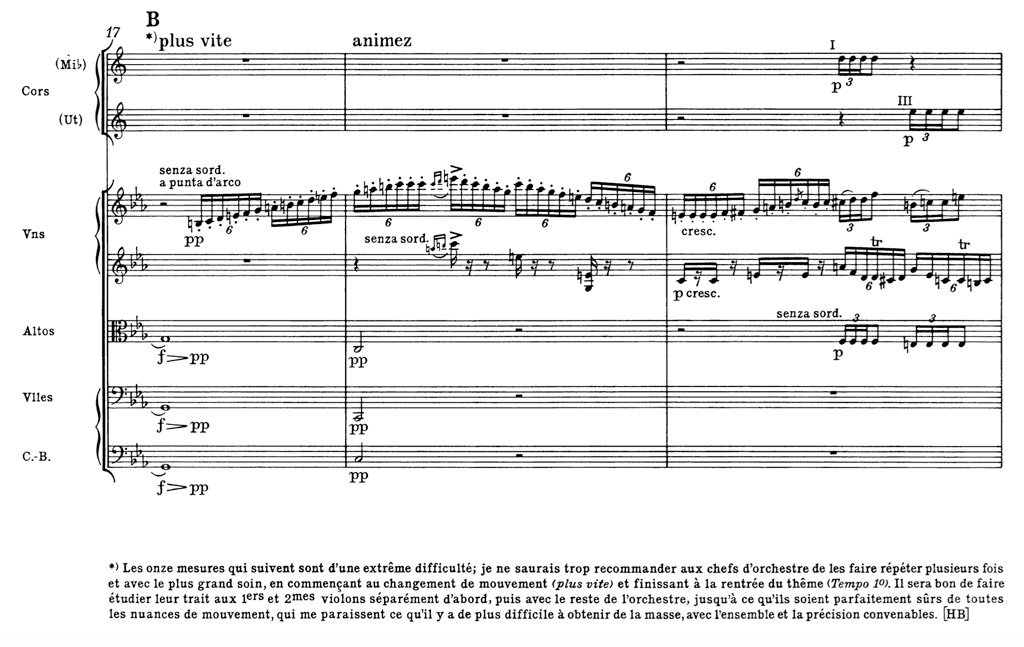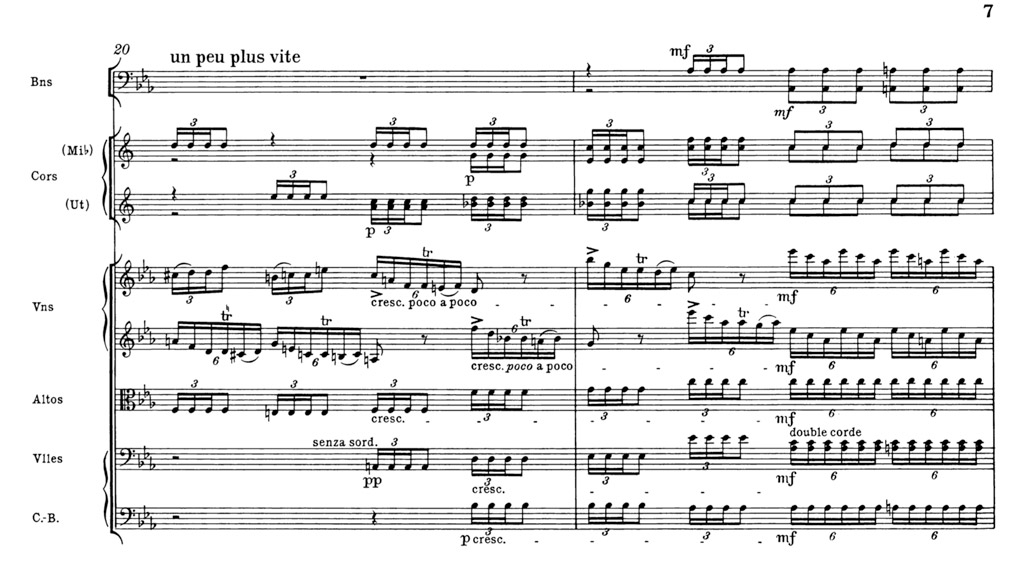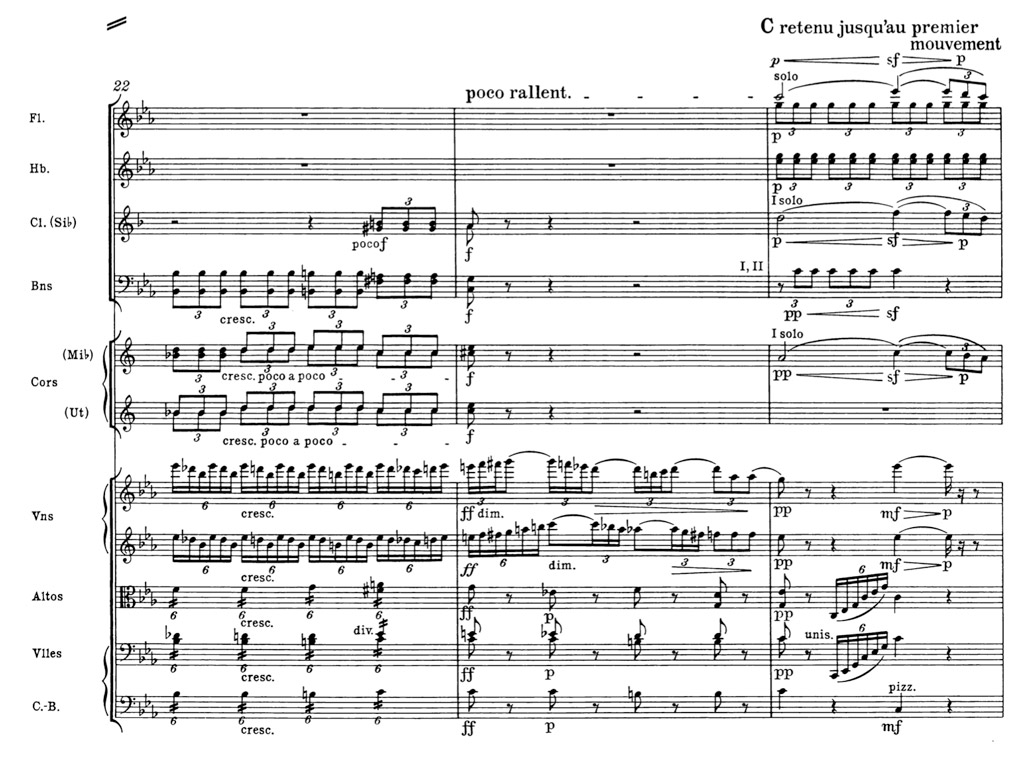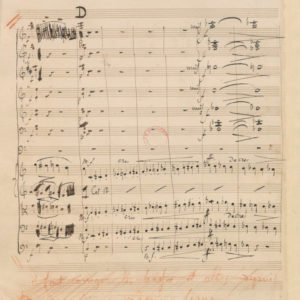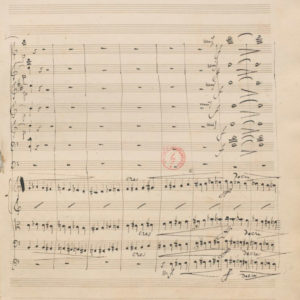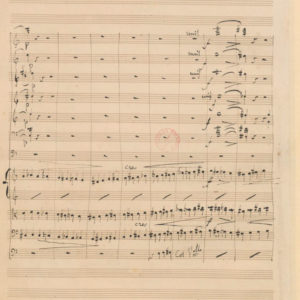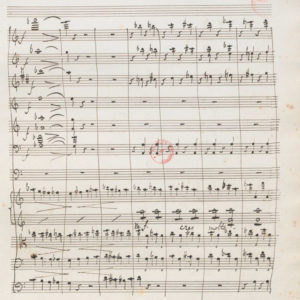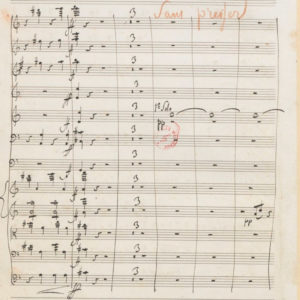Fantasizing at the guitar: Remarks on the compositional practice of Hector Berlioz
Table of contents
Erlend Hovland
Erlend Hovland (1963), is currently associate professor at the Norwegian Academy of Music, Oslo. After music studies, mainly orchestral conducting, in Trondheim, Oslo, Paris, Basel and Salzburg, he began his doctoral studies in 1990 at IRCAM, Paris. Hovland defended his thesis on the orchestration of Gustav Mahler at the University of Oslo, where he later worked as a post doc. fellow on contemporary opera.
by Erlend Hovland
Music & Practice, Volume 3
Scientific
Tags: berlioz, guitar, compositional practice, symphonie fantastique, improvisation
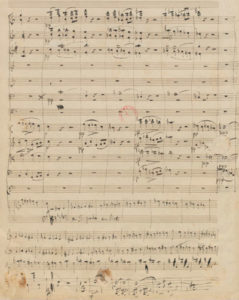 it has generally been assumed that … his
it has generally been assumed that … his
[Berlioz’s] compositional efforts prior to the
orchestral score would remain a mystery.
Kern Holoman1)D. Kern Holoman, Autograph Musical Documents of Hector Berlioz, c. 1818–1840 (Ann Arbor: UMI, 1974), p. 184.
Faute d’esquisses conservées, on ignore
absolument comment Berlioz composait.
Gérard Condé2)Gérard Condé, ’Berlioz : les paradoxes d’une conception orchestrale de l’harmonie’ in Analyse Musicale 2003/2, p. 24 (‘In the absence of sketches, we are left with no clues to how Berlioz composed’).
Hector Berlioz’s music has always attracted both harsh controversy and devoted interest, but he has never formed a ‘school’.3) My thanks and appreciation to Erik Stenstadvold, Darla Crispin, Laura Macy and Bjørnar Habbestad for reading and commenting on this text. I further need to thank Christina Kobb for the most detailed, inspiring and competent editing any author could wish for. Yet, since his œuvre is extensive and his style coherent, his music cannot simply reflect a state of folly. Nevertheless, how Berlioz composed has largely remained a mystery. For these reasons, a study of his compositional practice might be hoped to reveal some method or tendencies, which may also explain the stylistic coherence and the persisting controversial nature of Berlioz’s music. The hypothesis in this article is that not only did Berlioz compose ‘at the guitar’, but that he also used improvisation as a tool in his compositional practice.4)This hypothesis will be further substantiated in my forthcoming book The Berlioz Problem. Choosing ‘improvisation’ instead of ‘extemporization’ is mainly because Berlioz himself used this term in his Memoirs (see later). If this hypothesis is correct, the idiomatic qualities of the guitar may give a better understanding of Berlioz’s compositional practice and musical language.
Admittedly, and for several good reasons, this is a problematic hypothesis. As the literature repeatedly argues, Berlioz did not practice any instrument as an accomplished musician.5)The most excruciating description of Berlioz’s instrumental abilities comes from Sir Charles Hallé, in Life and Letters of Sir Charles Hallé; being an autobiography (1819–1860) with correspondence and diaries; edited by his son, C. E. Hallé, and his daughter, Marie Hallé (London, 1896), p. 65: ‘Berlioz was no executant upon any instrument (for being able to strum a few chords on the guitar does not count)’. More recently, Elliott Galkin has arrived at a similar conclusion, though in less provocative terms. Elliott W. Galkin, ‘Hector Berlioz, chef d’orchestre’, Revue de Musicologie 63/1-2 (1977), p. 43: ‘A la différence de Mendelssohn, de Weber, de Spohr et de Beethoven, Berlioz ne pratiquait aucun instrument en technicien accompli’. The general view is that he composed ‘silently’, sitting at a table with the feather pen in his hand, a view that is partly based on Berlioz’s own account in his Memoirs.6)‘When I consider the frightful number of platitudes which the piano brings forth every day … I cannot but thank the change which made it necessary for me to find out how to compose in silence and freely, and so guaranteed me from the tyranny of finger-habits, so dangerous to thought’ (Translation by Julian Rushton, The Musical Language of Berlioz (Cambridge: Cambridge University Press, 1983), p. 56. He wrote nearly exclusively orchestral music, which does not necessarily strengthen the idea of using improvisation as a compositional tool, and his lack of even on a rudimentary ability on the standard orchestral instruments (with the possible exception of the flute), makes it even more difficult to argue. Further, there are very few sketches from Berlioz’s hand, as he himself destroyed most of them. This does not exclude the use of improvisation as a compositional tool, but makes it even harder to validate.
On the basis of these arguments, Julian Rushton’s claim that ‘Berlioz certainly composed on paper, in silence, and not ‘at the guitar’ is both convincing and attractive, as it avoids questions about what appears to be the ‘great unknown’.7)Rushton, The Musical Language of Berlioz, p. 65. As scholars, we tend to favour a purified and ‘on paper’ conception of the compositional act, rather than something caught in a meander of practical considerations and messy materiality, partly indebted to fingers seeking music on an instrument. What is not within reach of the established tools of musicology (such as the techniques of analysis, harmony and form, and historiography) is easily disempowered and muzzled. To make these silenced acts speak must be the ambition of practice studies.
Certainly, it is difficult to comprehend how Berlioz, sitting in his studio, equipped with nothing but a feather pen, could compose such an original and complex music, not only inventing strange and previously unheard harmonic, melodic, and rhythmical patterns, but also creating new orchestral textures, often based on figurations hardly to be found in any other composers’ music. In fact, if this silent composing was all there is to say about his practice, one must concede that Berlioz, even as a young man, was in possession of a quite extraordinary musicality and a compositional ability that even surpassed Beethoven’s powers. What became possible only with much struggle and to great frustration for the increasingly hearing-impaired German composer, we now assume to be Berlioz’s modus operandi and his point of departure. What ‘makes matters worse’ is that Berlioz’s music from day one was quite original and different, and did not build on an acquired compositional practice informed and developed through the piano playing. Still, it is by no means usual for the French composer to be attributed such a high level of musical skill. Few if any other of the so-called Great Composers have so frequently had their musical education, skills and knowledge questioned.8)Already in 1832, in Revue Musicale, Fétis furiously attacked Berlioz for not being a musician, but someone who simply uses (or rather misuses) musical notation: ‘M. Berlioz n’est pas musicien, ai-je dit. Cependant il sait se servir de la notation de la musique’. His point is that ‘before you can be a musical inventor, you have to be a musician, something which M. Berlioz does not appear to have understood’. (‘avant d’être inventeur en musique, il faut être musicien, c’est ce que M. Berlioz ne paraît pas avoir compris’). And further, that Berlioz, ‘plagued by his vague desire to create, ignored the fundamental elements of [musical] creation, and what is even worse, he has no longer the age when learning these [fundamental elements] comes with facility’. (‘Tourmenté d’un désir vague de produire, il ignorait les premiers élémens de la production; et ce qu’il y a de pis, c’est qu’il n’était déjà plus dans l’âge où ils s’apprennent avec facilité’). Fétis’s argument is that an adequate musical education must be obtained in childhood if the future musician is to be capable of analysing his music with facility and efficiency. (‘Une éducation musicale faite dans l’enfance, bien dirigée et appliquée à une organisation favorable, peut seule donner cette qualité précieuse d‘analyse prompte et facile; ces conditions ne se sont pas rencontrées dans les études de M. Berlioz, et tout démontre maintenant que, quoi qu’il fasse, il n’y pourra suppléer dans l’avenir’). Revue Musical 46 (1832), p. 366. What is particularly interesting is that Fétis succeeds in presenting most of the ‘accusations’ that later writers would hurl at Berlioz, with perhaps one exception: Fétis did not pin down the importance of education to one instrument, the piano, as we would repeatedly find in later critics, for example in Charles Rosen’s seminal book, The Romantic Generation: ‘How did some composers escape the bad effects of the degenerate educational system deplored by Chopin? Berlioz did not have, in his training, the necessary corrective that almost every other contemporary composer had from childhood: the Well-Tempered Keyboard of Johann Sebastian Bach. This was the basis of instruction at the piano’. Charles Rosen, The Romantic Generation (Cambridge: Harvard University Press, 1995), p. 554. Further, the argument proposed by some scholars, that Berlioz was highly capable of ‘auralizing’ a written score, is further bluntly rebuked by reading the testimonies of Sir Charles Hallé:
Perhaps many undoubted crudities in his works would have been eliminated had he been able to hear them before committing them to paper, for I had several proofs that the eye alone was not sufficient to give him a clear idea of the effect of his musical combination. Thus at the time when he scored Weber’s ‘Invitation à la Valse’ for the orchestra, he made me play it to him.9)Hallé, Life and Letters, p. 65.
And when Richard Wagner wrote that ‘I had presented him with a copy of my Two Grenadiers, but could, however, never learn any more from him concerning what he really thought of it than the fact that he could only strum a little on the guitar, he was unable to play the music of my composition to himself on the piano’,10)Richard Wagner, Mein Leben (1865–80), translation from My Life (New York: Dodd, Mead and Company, 1911), p. 194. he not only described Berlioz’s deficit as a musician (on any instrument), but further implied that he could not, simply by reading the score, get a sufficiently good idea of the music.
More recently, Pierre Boulez criticized Berlioz’s lack of a good musical ear. According to him, Berlioz’s solution, ‘faute de mieux’ – and problem – was that he picked out his chords on the guitar.11)Pierre Boulez, Conversations with Célestin Deliège (London, Eulenburg, 1976), p. 20: ‘On the other hand, as I have said, there are awkward harmonies in Berlioz that make one scream; it is easy to see that he picked out his chords on the guitar and could hear almost nothing. It is all very well to claim that Berlioz’ unusual choral placing is a sign of “genius”: I think rather that it was clumsiness.’ ().This assumption has been around for some time, and in Paul Jerald Dallman’s thesis, Julian Rushton’s book and an article by Alex Weidenfeld, the influence of the guitar has been raised as a topic of inquiry. Even though these authors are more sympathetic to the guitar than Boulez (and Sir Charles Hallé), their conclusion is that the influence was mainly of a passive character, and limited to predilection for certain chords (something that was developed in him during his formative years when he played the instrument more frequently).12)Weidenfeld concludes in his article that the attempts to explain the influence of the guitar on the demanding art music of the nineteenth century cannot succeed. Alex Weidenfeld, ‘Hector Berlioz und die Gitarre’ in Musik und Emanzipation: Festschrift für Freia Hoffmann zum 65. Geburtstag, ed. Marion Gerards (Oldenburg: BIS-Verlag der Carl von Ossietzky Universität, 2010), p. 128: ‘Die Versuche, seine Beiträge als eine wesentliche Partizipation der Gitarre an der anspruchsvollen Kunstmusik des 19. Jahrhunderts zu deuten, mussten also notwendig scheitern’. The most extensive study of the Berlioz’s relation to the guitar is a master’s thesis written by Paul Jerald Dallman. The author, who knew well the idiomatic properties of the guitar, nevertheless concludes that ‘Berlioz often speaks of composing away from any instrument. With the exception of Mephistopheles’ Serenade, which represents an afterthought, it is unlikely that he ever conceived a composition on the guitar and transferred it to the orchestra’. Paul Jerald Dallman, Influence and Use of the Guitar in the Music of Hector Berlioz (MA Thesis, University of Maryland, 1972), p. 195. As already mentioned, Julian Rushton did not think that Berlioz composed ‘at the guitar’, however he assumed that ‘the early study of the guitar was certainly productive of singularity of utterance and probably did have a permanent if limited effect on his musical thought’. Rushton, The Musical Language of Berlioz, p. 60.
The topic has also been a returning theme in the writings of leading Berlioz scholars. Even regarding the composer’s use of the orchestra, Tom S. Wotton states that ‘beyond a fondness for pizzicato, there is no trace of the guitar in Berlioz’s orchestration’.13)Tom S. Wotton, Hector Berlioz (London: Milford, 1935), p. 57. And further on the subject of Berlioz’s ‘musical thought’ and harmony, Wotton concludes: ‘Too much stress, however, must not be laid on Berlioz’s practice of the guitar. … The influence of the guitar on Berlioz’s harmonic ideas is probably infinitesimal’.14)Wotton, Hector Berlioz, p. 59. So on the basis of these inquiries, it is not difficult to agree on what Hugh Macdonald writes in a letter to Dallman: ‘the idea that Berlioz’s style … was influenced by the guitar has only ever been thrown out in various books and articles and never properly demonstrated. The result is that I, for one, tend to think that its influence was minimal’.15)Hugh Macdonald in a letter of 8 September 1967 to Dallman. See Dallman, Influence and Use of the Guitar, p. 119. Now, if both the specific literature on the subject (i.e. Berlioz and the guitar) and the leading Berlioz scholars were right in their judgment of the influence of the guitar, our hypothesis must be falsified.16)As we soon shall see, D. Kern Holoman is also reluctant to accept the idea of the guitar being a major influence on Berlioz’s composition. Berlioz could neither have composed nor possibly improvised on the guitar.
There are, however, other sources of information, less accentuated in the scholarly literature, which give a different perspective on the matter. The best-known ‘source’ is the saying attributed to Berlioz: ‘The guitar is a small orchestra’ (‘La guitare est un petit orchestre’). Even if its veracity remains uncertain, the phrase may indeed serve as a point of departure for an inquiry into the relation between Berlioz’s orchestral writing and his guitar playing. A better source, however, is the testimony of Leon Gastinel. In Dallman’s study, this is presented as follows: ‘When his fellow composer, Leon Gastinel visited his lodging in Paris in 1840, he reported that the only furnishings in Berlioz’ working room were a chair and “a table on which lay his guitar, which served him in the composition of his works”’.17)Dallman, Influence and Use of the Guitar in the Music of Hector Berlioz, p. 45. Interestingly, Holoman renders this anecdote quite differently: ‘A rather shocked description of his workroom in the rue de Londres was left by the composer Léon Gastinel. Berlioz had taken over an attic room, just beneath the mansard, equipped with only a table, a chair, and his guitar – a souvenir, not an instrument for composition, played most often when Louis wandered in’.18)Holoman, Berlioz (Cambridge, 1989), p. 215. Two sentences later, Holoman continues by saying that ‘Berlioz did in fact like to have a piano nearby, at least, and owned one as early as 1826’.19)In his article, ‘The Present State of Berlioz Research’, Acta Musicologica 47/1 (1975), pp. 31–67, Holoman’s evaluation of the influence or use of the guitar in Berlioz’s compositional practice was consistent with the general view of most musicologists. Here he states ‘that Berlioz’s vertical sonorities and voice-leading are rooted in the capabilities and limitations of the guitar is … far-fetched; that his harmonic practice was greatly affected by his early experience as a guitar player is unlikely’. (pp. 44–5). Neither of these accounts is accurate, and their differences may reflect the authors’ general view on the place of the guitar in Berlioz’s development as a composer. What is actually stated, in the citation found in Pierre Citron’s edition of Berlioz’s Correspondance Génerale is: ‘A chair, a table on which lay a guitar that served him composing his first works’.20)Hector Berlioz, Correspondance Générale, ed. Pierre Citron, vol. I (Paris, 1972), p. 269: ‘Berlioz habitait rue de Londres et avait installé son cabinet de travail dans une mansarde sous les toits. Une chaise, une table où se trouvait la guitare qui lui servît à composer ses premières œuvres, voilà tout l’ameublement du grenier où vivait le génie dont la mort a marqué l’heure de l’apothéose’.
Yet another source is the vivid description of Berlioz playing the guitar by Ernest Legouvé, which was introduced to the English language in Wotton’s important book of 1935. When Berlioz visited Legouvé in 1833, the composer:
picked up his instrument [the guitar] and commenced to sing. What? Boleros, dance airs, melodies? Nothing of the kind? The finale to the second act of La Vestale! The chief priest, the vestals, Julia, he sang everything, all the characters, all the parts. Unhappily, he had no voice. But that did not matter! He made one. Thanks to a system of singing à bouche fermée, which he practised with extraordinary skill, thanks to the passion and musical genius that inspired him, he drew from his chest, his throat and his guitar unknown sounds, penetrating lamentations, which, mingled at times with cries of admiration and enthusiasm, even eloquent commentaries, united to produce an effect so extraordinary, so incredible a whirlwind of brilliancy and passion that no performance of the master-piece, even at the Conservatoire, has moved me, transported so much as this singer without a voice and his guitar. After La Vestale some fragments of the Fantastic Symphony.21)Wotton, Hector Berlioz, p. 58, quoting Ernest Legouvé, Soixante ans de Souvenirs I (Paris, 1886), pp. 294–5.
Wotton’s immediate (and incredulous) comment was: ‘One wonders which those fragments were’. Moreover, what neither Wotton nor the other authors who have quoted this anecdote have included is the very interesting first sentences that precede the above description in Legouvé’s memoirs:
“All right, let us now celebrate the wedding. Let’s make some music”.
He accepted enthusiastically. But how? I did not have a piano in my bachelor apartment, and even if I had, to what use would it be? Berlioz played [the piano] with only one finger. Luckily, we had one triumphant resource, the guitar. The guitar encapsulated for him all the instruments, and he did play it very well. He took it, and began to sing.22)Legouvé, Soixante ans de Souvenirs I, pp. 294–5. My translation.
Interestingly, even if we have not been able to find the source for the ‘bon mot’ attributed to Berlioz, ‘La guitare est un petit orchestre’, Legouvé gives a version here, claiming that for Berlioz the guitar did in fact represent all the instruments. But well as important is the richness in his description of Berlioz’s lack of skills on the piano, which were largely compensated by his abilities on the guitar. Of course, this description did not cohere with the general view held by Wotton or other musicologists (cf. the basic tenet of Wotton of the ‘infinitesimal influence of the guitar’, quoted above), which may explain why it has previously gone unnoted.
In addition to these sources, we may also include Berlioz’s own account from his Memoirs of how he entertained Mendelssohn by singing Moore to his own guitar setting,23)‘He [Mendelssohn] liked me, with my wearied voice to hum my own setting (with guitar) of Moore’s melodies. He always had a certain amount of commendation for my – little songs!’ Hector Berlioz, Mémoires d’Hector Berlioz, ed. Pierre Citron (Paris, 1969), 51. (Reference is made to chapter and not to page). (My translation). and how he kicked his guitar, ‘standing against the table’, as late as in 1843.24)Berlioz, Mémoires, 53. And yet, even if we consider these testimonies and other citations as indications on a more active use of the guitar, they do not necessarily support our hypothesis that he improvised on the guitar. This would need two further suppositions:
- That his use of the guitar was not simply restricted to finding some chords or to accompany his singing. This would hardly be improvising.
- That the music he composes must largely be ‘playable’ on the guitar. If not, he would hardly be able to improvise.
Now, both these suppositions are, as we have seen, at odds with even the most favourable musicological evaluations of the role of the guitar in Berlioz’ music, so the onus is on me. Luckily, again there are some less-often-cited literary sources that can strengthen the idea of Berlioz as improvisator.
Improvisation (and the guitar) in the literature
Berlioz’s Memoirs is the most important source we have for understanding the composer’s early period, his education and his artistic development. The problem, however, is the literary ambitions of its author; he could prefer a good story to an accurate one, and he undoubtedly used the opportunity to champion his own views and interests, as well as explicitly trying to forge the ‘right understanding’ of him as an artist.25)Berlioz himself was fully aware of the many functions or ‘roles’ of his Memories. For example, in a footnote to his account of how he kicked Crispino, his Italian friend from the Abruzzi mountains, he writes: ‘This is not true, and proceeds from the tendency which artists always have to write for effect’. Berlioz, Mémoires 38. As already mentioned, it is in his Memoirs that Berlioz claims to be a silent composer, but interestingly, as opposed to the many composers who were depending on their use of the piano, and thus, inscribing in their music all sorts of pianism. Yet, in other passages from his Memoirs, Berlioz presents himself as a keen improviser on the guitar.
During his stay in Italy and his escapes to the mountains of Abruzzi, Berlioz tells how he sometimes brought the guitar, rather than a gun, on his hiking tours, and ‘improvisant alors un étrange récitatif sur une harmonie plus étrange encore’.26)Berlioz, Mémoires 37. Not only did he improvise a recitative but also an even stranger chord progression. Later, in the same escapes from Rome, he describes how he entertained and played together with the locals and improvised his saltarelli on the guitar.27)‘questo signore qui suona la chitarra francese; et le classique tambour de basque accompagnant mes saltarelli improviseés’ Berlioz, Mémoires 37.
However, the most interesting passage in the Mémoires is dedicated to his composition of Harold en Italie:
Notwithstanding its complicated structure, I took as little time to compose this symphony as I usually did to write my other works, though I employed considerable labour in retouching it. In the Pilgrims’ March, which I improvised in a couple of hours one evening over my fire, I have for more than six years past been modifying the details and think that I have much improved it.28)Berlioz, Mémoires 45. (My translation).
According to this testimony, improvisation was a constitutive part of his compositional practice, and though he needed only a couple of hours to create the basic structure and the harmonic texture of this music (the second movement, the ‘Marche des Pèlerins’), he needed years in order to refine the work. But how Berlioz, during these two hours at the fireplace, improvised the second movement of this symphony is not described. The most likely solution is that he played his guitar, not least as he obviously also developed ‘la complexité de son tissue harmonique’, and the guitar was the only instrument he played that was capable of rendering a harmonic texture.29)Interestingly, this is not unlike Gustav Mahler, who after some few intense summer weeks, when he crafted the ‘particelles’, needed years to orchestrate and revise his works.
Examining the music, the Symphonie fantastique
As already mentioned, there is very little source material that reveals the composer at work. With the exception of some sketches to his opera Les Troyens one can find only bits and pieces here and there. However, to save on the expensive sheet music, Berlioz occasionally pasted a blank page over existing passages in the autograph score in order to rewrite them. Years later, when the glue has lost its adherence, one has been able to see both what was under and what was on the verso page. It is this ‘coup de chance’ that allows us to examine some of the rewritings in the Symphonie fantastique. Another is to compare the autograph score (1832) with the first publication of the printed score (1845).
The first rehearsal of the symphony was in May 1830, and it was a disaster, partly of practical reasons.30)See Berlioz, Mémoires 26. Both before the premiere of the work, later that year, and the re-premiere in 1832, we know that Berlioz made important changes to the score, and in particular to the first movement. It is some of these changes that we now can reconstruct based on what was first written beneath the so-called ‘collettes’ in the autograph score and what was changed in the printed 1845 score. Dating the changes is problematic. We know that Liszt based his famous transcription of this work on the autograph score (finished at the end of 1832).31)According to Holoman (Autograph Musical Documents, pp. 384-85), there were five different stages in the compositional process (including the revisions) of the work:
1. Original version, rehearsed in May 1830
2. Slightly revised version, performed in December 1830
3. Completely rewritten version from Rome (1831-32) of the first three movements, first performed in Paris on 9 December 1832, (the symphony was in this form when transcribed by Liszt)
4. Version in the “advance edition,” 1844-45
5. Version in the general publication, 1845 Since the changes in our first example are neither included in Liszt’s transcription nor in the autograph score, we must suppose that they were introduced later. In other words – and as Berlioz himself testified in his Memoirs – he often had to rethink and find a better solution even to what had already been performed in concert and transcribed into the piano score of Liszt (on which Schumann based his famous analysis). Since both our cases are anything but simply enhancements of the orchestral texture, they may further illustrate how he had to develop new compositional ideas in order to solve musical problems that were exposed during the early rehearsals and performances of the work.
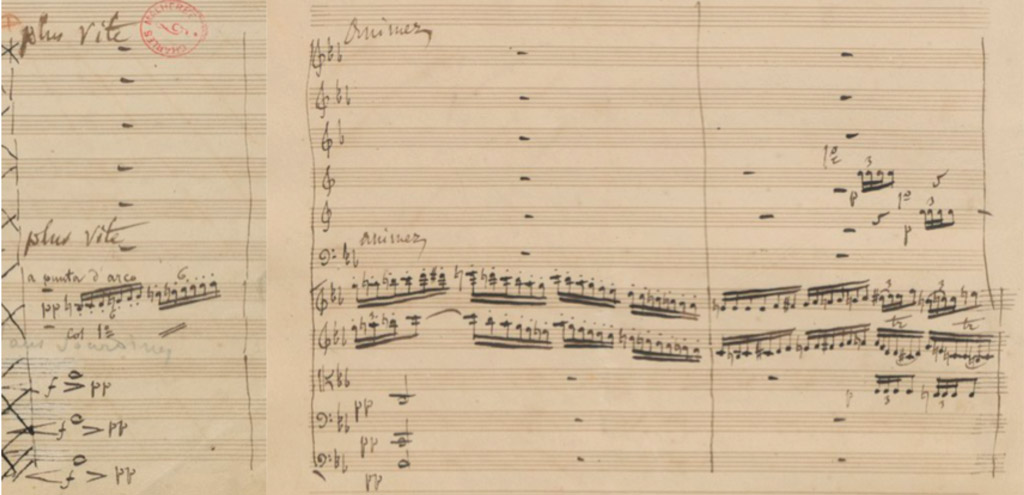
Figure 1: First version of Symphonie fantastique, 1st mvt., bb. 17-19, from the 1832 autograph score.
The first Case
Our first case, the ‘plus vite’ section of first movement, beginning in bar 17, is probably one of the most rehearsed passages in the orchestral repertoire from the first half of the nineteenth century. The composer was acutely aware of the difficulties in the performance, which is why he also furnished the score with a highly original warning at the bottom of the page:
The following 11 bars are of unusual difficulty. I cannot sufficiently advise the conductor to repeat them, and with the greatest care, from the change in time (Più mosso [‘plus vite’, b. 17])) to the resumption of the theme (Tempo I [b. 28]). It is a good plan to take this passage at first with the violins (1. and 2.) only and afterwards with the rest of the orchestra until they are perfectly familiar with all grades of the tempo, which seems to me to be the most difficult to obtain with the necessary unity and exactness from a number of players. [‘parfaitement sûrs de toutes les nuances de mouvement, qui me paraissent ce qu’il y a de plus difficile à obtenir de la masse, avec l’ensemble et la précision convenables’.].32)Berlioz, Symphonie fantastique (New York: Dover Publications, 1984), p. 4.
This caution may be read as a composer-conductor’s preoccupation with obtaining a good technical rendering of the music, a view that would be quite understandable given its fragile orchestral texture. However, what is actually emphasized in this warning is the need to rehearse this passage many times, beginning with the two groups of violins, until everyone is ‘perfectly familiar with all grades of the tempo’ (cf. ‘parfaitement sûrs de toutes les nuances de mouvement’). In other words, this reflects a passage where well-crafted changes and nuances of tempo (the ‘mouvement’) – and of the orchestral masses – are central to the musical idea itself. (Of course, the English translation is a simplification of Berlioz’s French). To my knowledge, a similar musical passage (or caution) is not found in any music prior to this work. Yet, the formal function of the passage can easily be understood by examining the tempo modifications (‘plus vite’, ‘animez’, ‘un peu plus vite’) and the dynamics: a slow and languishing introductory music, a change – in metre, rhythm, character and tempo – creates a bridge towards a gradual build-up of the first musical climax, strangely over-enthusiastic and disconnected from the preceding opening character. This formal function was already inscribed in the first version (see Figure 1); so why did he rewrite the passage?
Examining the first version (see Figure 1), it is hard to imagine that a composer ‘at the piano’ would have written a music that is so lean. There are no filler notes, no accompaniment, no real chords; yet, as the score indicates, this should be played in an energetic manner, with accelerando and bringing forth rhythmic vitalization and rhythmic variation in order to effect the passage from the slow introduction to the exalted music. But interestingly, all that is notated here can be played on the guitar. (See Figure 2). What we have is simply a bass note (the unisons of violas, cellos, and contrabasses) and a passage in parallel thirds (of first and second violins), which leads to a chromatically ascending figure, still in parallel thirds. All these figures will become important motivic ‘building blocks’ in Berlioz’s later compositional edifice, blocks that can be regarded as idiomatically related to the guitar playing. In fact, if we play this on the guitar we see that the passage begins within the fingering of the most common chord position on the guitar, the G major (in the first position on the instrument), here played as an ascending run up to the 7th (the F on first string), over a sustained G in the bass (bar 17). The shift of hand position is already present in the first autograph score; meaning that the next bass note (the C of bar 18) could imply a shift in position (to the 8th fret), which also makes it possible to play the next ‘melodic’ figure as well holding the bass. And when it is no longer possible to hold the bass on the guitar, we find that the bass line is discontinued in the score as well.
The use of scales of thirds is quite guitaristic (although it is more frequently used in ascending than in descending runs). In this example, it is a way to ‘fill out’ the texture. In fact, this ‘device’ could reflect an attempt to use the idiomatic character (and limitation) of the guitar in order to answer the expectation of a more opulent orchestral texture. Instead of procuring accompanying chords and independent inner voices, all rhythmically enlivened, the guitar offers more easily the opportunity to add thirds (or other intervals) to the melodic voice.
The lack of activity in the bass line is further revelatory for a compositional practice based on the guitar. It is difficult to maintain equal independency of both upper and lower voices when the music is played (or conceived) on this instrument, as all voices must be played within the compass of the left hand. Interestingly, these ‘findings’ are also to be found elsewhere in the œuvre of Berlioz. In particular, the use of parallel motion between the voices (rather than contrary motion) is a clear tendency in Berlioz’s orchestral writing.
If we compare this first version with the final score, the obvious question is how to explain the rewriting. As already mentioned, the rewriting of this passage was done after the work had been performed, at some point after 1832. What is particularly telling is that the final version does not show the emendation we would expect: that the first version was ‘too guitaristic’, that it lacked harmonic solidity, and that it did not present a proper orchestral texture. Instead, Berlioz directs his rewriting in a quite different direction, and by doing so he seems surprisingly indifferent to the obvious orchestral shortcomings of the first version. (See Figure 3 for the revised orchestral version). To this there are, however, some explanations or arguments, which mainly relate to the benefit of further simplification, characterization and (use of) idiomatic creativity.
To claim that there was a need of simplification may surprise, given the already lean texture of the first version, but the point is that both the upward run in unison and the sequences in parallel thirds (played by first and second violins, see Figure 1) would ungraciously add difficulties to coordination, and in particular as the seating of the Berlioz orchestra had the violins grouped at opposite flanks of the stage. But more importantly was the need for characterization. The first version is rather ‘bleak’, and to some degree it overuses the parallel thirds. The third argument, related to the use of idiomatic creativity, could be seen in the sanction of the attempt to use the guitar as a means to write conventionally (accepting the claim that the first version is more conventional and solidly written for the orchestra, as it uses a broader brush). If we accept that Berlioz did use the guitar to work on improving this passage, we might seek clues to what this instrument can contribute idiomatically to the creative act.
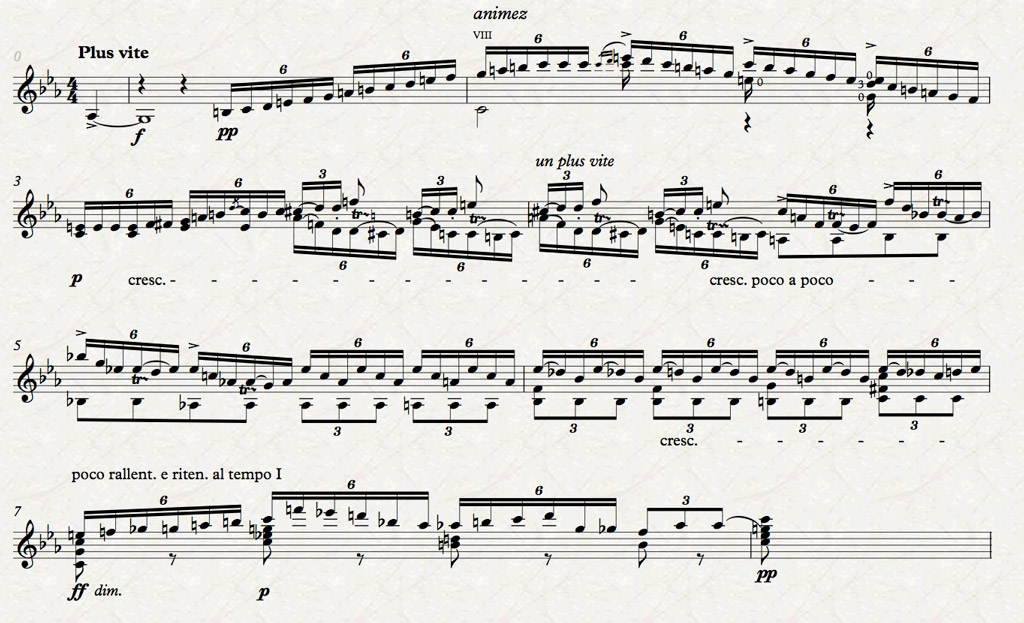
Figure 4: Guitar transcription of Symphonie fantastique, 1st mvt., bb. 17-23 (of the revised (1845) orchestral version.
Indeed, the comparison of these two versions reveals that the revised 1845 version is not less guitaristic, but more. It sounds better on the guitar and is definitely easier to play in tempo. (The descending run of parallel thirds in the first version does neither sound particularly good, nor is it easy to play fast on the guitar). The final version is as idiomatically written for the guitar as it possible can be. (See the transcription back to the guitar: Figure 4). In the final version, Berlioz may have used the open strings (first E, then both E and G, in b. 18 [b. 2 of the excerpt]) not only to help the change of hand positions (from 9th position to 1st), but also to give rhythmic accentuation. He also uses the ‘naturally’ given trills and grace notes (that is within the hand position), in order to emphasize the rhythmic accentuation of the music. In other words, what is afforded idiomatically by the guitar is directly translated into the orchestral writing. But there is more.
In this example we see that the repetition of the note E in the second measure of ‘Animez’ (which in the first version is hardly noticeable as a specific trait) is developed in the score. The three repeated notes are turned into a ‘swinging’ or ‘waltzing’ rhythmic figure that gives to the whole section an inner element of identity and movement. It is this motivic clarification, or rather, the finding of an element of coherence, that now makes the passage ‘logical’; it binds together all the bars of this passage, and clearly defines the character of the music. Obviously, it is not the abstract, silent feather pen on the paper that allows for composing or developing ideas. Hardly any surprise, really.
So instead of providing a passage of rather insipid music (and orchestrally cumbersome writing with its doublings in unisons and parallel thirds), the final version presents a gradual growth of both intensity, rhythmic and figurative complexity, and brings forth the triplet figure as a coherent element, first presented in the figure prior to the chromatic ascending parallel thirds in the first version.
The continuation of the example
As mentioned, this orchestral passage is unusual, if not unique, in the repertory (at least up until then). In the course of seven bars there are clearly notated changes in tempo (first ‘animez’, then ‘un peu plus vite’, then ‘retenue’, and last ‘rallentando’), active use of dynamics (from pp to ff), rhythmic, metric and orchestral intensification, an active use of ornaments, different accentuations and chromatic ascending motion, all of which create a ‘build-up’ never heard before in music history (and making the Mannheim rocket sound like a tiny, wet firecracker). And what is surprising is that every figure in this complex orchestral music is playable on the guitar and reflects its idiomatic qualities: the use of finger legato, trills, open strings, and a unconventional chord progression, but a progression that uses idiomatic position shifts of the left hand, and the opportunity to create more musical tension by simply ascending chromatically one or two notes to the next chord, while letting the E-flat become the central note around which everything rotates (from the second half of ‘un peu plus vite’, b. 20). So, on the basis of presenting some of the most common chords on the guitar, G (7), C, D and A major, and their typical ornaments (the idiomatic use of finger legatos and trills, all within the hand position), a new orchestral texture and a new elaboration of musical form are created. Moreover, this example further illustrates how important the so-called ‘secondary parameters’ (i.e. tempo fluctuation, playing techniques, ornamentation, dynamics and so forth) are to Berlioz’s orchestral and formal thinking. In this example, these parameters do not appear to be something added to the passage later on; rather, it is constructively present in the musical material, in the mere conception of what is the physicality of the sound.33)The suppression of the three measures prior to the beginning of our example, illustrates how the musical idea of a nearly gestural moving music is clarified.
Now, is there a contradiction or clear distinction between fantasizing (or improvising) and composing? This case shows how experimenting on the guitar, how seeking new material that is utterly idiomatic for the instrument, also becomes a way to refine the compositional writing. It is a way to be ‘in the music’ in a practical, even tangible or ‘messy’ way. Pragmatic solutions and idiomatic limitations related to the playing of an instrument are positively redefined as new compositional material. If this example challenges our ideas of compositional practice of orchestral music, one reason is that it is not ‘naturalized’ by the piano. Unlike the piano, the imprints of the guitar stand out more easily and challenge the expectations of the listener. They are not already ‘neutralized’ through decades, if not centuries, of adopting pianistically conceived music to the orchestra.
The second case
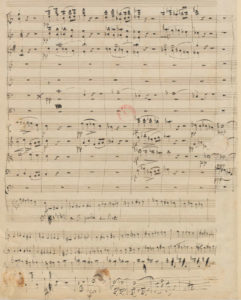
Figure 5: The first orchestral version of the beginning of the development section (Symphonie fantastique, 1st mvt., of what was to become bb. 196-240).
Fortuitously, the next proof of a substantial rewriting of the autograph score is another emblematic passages of the Symphony fantastique, a passage that also posed itself as a musical problem for Berlioz. This example is drawn from the beginning of the development section and, as we shall see, at first Berlioz tried to meet the expectations created by the Beethoven model. His first version, again recognizable under the pasted pages, does use thematic material from the exposition, and he tries, as the sonata form dictates, to juxtapose, sequence, and modulate the motivic material (see Figure 5).
In fact, the first version of our second case shows Berlioz trying to write according to what he had learned at the conservatoire. As a clever student, he introduces the motive for the modulating sequence already in the bar of cadence before this section (see the bass line, first bar of the Figure 5 excerpt).
Then a modulatory section continues with the two-bar motive followed by two further sequenced and modulated repetitions. Again, as in the first example, the idiomatic character of the guitar is strongly present, but in this case, it does not provide a creative surplus but becomes rather a creative inhibition that gives the music an insipid character. It leads nowhere. Berlioz tries to induce some energy by simply adding a sforzando – for him this was a very uncharacteristic ‘solution’, as it is superficial, not grounded in the music itself – but the music simply runs out of steam. Clearly, the idiomatic limitations of the guitar give no solutions or new material to this passage (see Figure 6). In this instance, the instrument does not permit the composer to develop the needed contrapuntal and modulatory technique (it runs out of strings and options), partly because the motivic material he applies is too restricted (and compound, as both the polyphonic voices are too closely knitted together, reflecting the restriction of the left-hand fingering). The point is that the compositional technique he tries to apply is hardly consistent with the idiomatic character of the guitar.34) As this is in the development section of the first movement (accepting as most would do the shadowy presence of a sonata form in this music), Berlioz’s concern seems to have been to deploy the expected thematic-motivic work ‘Auskomponierung’. See also Berlioz, Traité d’Instrumentation et d’Orchestration, ‘La Guitarre’.

Figure 6: Guitar transcription of the first version from the development section at b. 196 (compare the first orchestral version of Figure 5).
Interestingly, at the bottom of the page of the original score (Figure 5) we see a rapidly notated idea, just roughly presented, leading towards what is marked as a sustained note in D on horn. In itself, this does not seem particularly noteworthy, but these few dots will make up an important section of the work. This ‘doodling’ reveals a strike of inspiration, but it is one utterly based on the guitar. For the fantasizing guitarist, this notation was more than sufficient. He needed only to write the first few chords, then simply the upper note (see Figure 5, where he notates ‘3 parte en sixtes’) and by this sketchy scribble, he found a short-form notation that created more than 40 bars of new music, including the climax of the first movement. (See the revised version in the autograph score, Figure 7). Even though these chromatically moving chords can be played on the piano (cf. Liszt’s transcription), they reveal the intrinsically idiomatic thinking of a guitarist: the use of chromatically moving chords.
These chords, which by fixing one (chord) fingering, can easily move frets up or down and play chromatically parallel chords with greater simplicity that the main chords of a tonal cadence (quite unlike idiomatic playing on the piano). Another interesting aspect is that the apex of this build-up, the A-major chord, is played on the last possible frets of the instrument (as it was in Berlioz’s day). Undoubtedly, he found this solution to the previously stale music both ‘on paper’ and ‘at the guitar’, but he also had his mind on the orchestra, and appears consciously to direct this long passage towards the sustained D in the horns. (See the transcription, Figure 8).
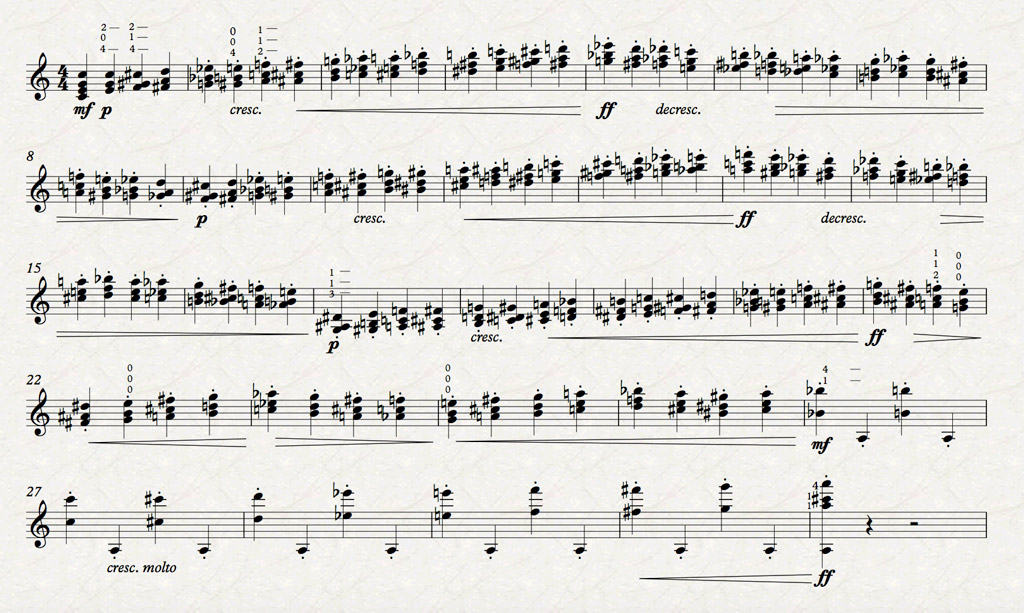
Figure 8: Guitar transcription of Symphonie fantastique, 1st mvt., bb. 198-228. See also how Berlioz changes the pattern and uses only open strings in order to facilitate the shift of positions in (here) bb. 21, 22 and 24.
Again, this case illustrates how new musical ideas are created from a play with utterly idiomatic figures and ‘moves’ on the guitar. It is rhapsodic, idiomatic, and ‘messy’; reflecting anything but abstract silent desk writing. This long sequence is simply cut in. It is extended in time, and it builds its own climax from the same new musical material by which it is generated, the chromatically moving chords. It replaces music that is far more correct, in the sense that it initially tried to accommodate itself to the demands of the symphonic genre by fulfilling the demand of sequencing (in a hapless imitation of a Beethovenian compositional practice). This musical material challenges tonality and the organization of phrases towards conventional cadence, it is neither harmonic nor melodic, but through its outline, a gestural and dramatic form is created. From the ‘inside’ of the idiomatic and motivic figure (the chromatically moving chords) a self-sufficient means is generated that builds a gestural form. This is a typical tendency found in Berlioz’s music. It reveals the oblique relation; a music that cannot be reduced to the simplistic categories of harmony, melody, rhythm, progression and form, but seems to combine all these in new and inherently compound ways.
This case further illustrates Berlioz’s ability to think (and write) music as primarily plastic or spatial entities, and not restricted to what is graphed in the score, fulfilling the demands of symphonic forms and harmonic and tonal structure. Again, it is the physicality of music that is emphasized. Also in this second case, we could attribute many of the changes to tendencies that are generally present in Berlioz’s compositional practice. We find:
- Tendency towards a leaner, less full orchestration (cf. the scarcity of filling voices and accompanying figurations).
- Tendency to suppress the use of ‘orchestral pedal’: By trusting the orchestral figures as such, even if they do not procure harmonic material or the prolongation effect the pedal has on the piano, Berlioz dares to develop a ‘pedal free’ orchestration.
- Tendency to trust simplicity, in particular when simplicity is enforced by greater characterisation. The point is, if you have a good idea, give it a clean and strong presentation.
- The secondary elements are strongly present and clearly indicated in the autograph score. Even if some of the dynamic and agogic markings might have been added later, which seems unlikely, partly due to the consistency in ink, but more importantly, that also the erased part in the autograph score is marked with precise dynamics and tempo indications, ‘modes de jeu’ (as pizz.), and phrasing slurs. The dynamic precision in both versions is surprisingly consistent. In other words, there is a tendency to make the secondary elements integral to the compositional material and activity from the start, not as something simply added later for ‘flavour’.
Conclusion
Both our case studies present solutions to musical problems that were initially created by an attempt to use more conventional orchestral and compositional techniques (i.e. to write a more opulent orchestral texture and the use of modulatory techniques in the development section). If it was the musical characterisation that gave the solution in the first case, it was the construction of moving orchestral masses, in fact, the sheer physicality of the music that was emphasized in the second. And neither characterisation nor the physicality of orchestral masses was obtained by filling in existing schemes or by using conventional musical means. What our cases illustrate is how Berlioz chooses to develop character and sonic function from within the material itself. Again, we must mention the oblique relation present in Berlioz’s music, a way of thinking musical material as compound and not as a combination of the ‘primary’ musical parameters under the auspices of one dominant, that is, either the melody or the harmony. Certainly, using established forms dictates the music, not least the thematic material. So, as Berlioz sought (or was forced) to dig out a different material, due to his use of the guitar, the conventional forms could not be slavishly followed. Instead, he seems to obliquely combine form and material into something the music can implement in a free and – at times – dissolving manner.
Both our cases point towards a concept of music beyond the notated score. The musical novelty of Berlioz becomes apparent in his prioritizing of musical (and dramatic) function, not as something depending on the structures created by the graphs on a paper, but as something sounding, something present in the orchestra and in the pure physical qualities of the music. For Berlioz, music becomes ‘dramatically organized sound’. Schumann seems to go in the same direction when, in his famous 1834 article in Neue Zeitschrift für Musik, he argues and refers to what was a contemporary commentary in Paris: ‘Que cela est fort beau, quoique ce ne soit pas de la musique’.35)Schumann used the French words in his article. An English translation could be: ‘Sure, it is very beautiful, but it is not music’.
Still, everything Berlioz does in these two cases, both in the original versions and in the final versions, is – rather surprisingly for an orchestral work – within the boundaries of what is playable on the guitar. It is by seeking out even more innovative and idiomatic characteristics on the guitar that he finds the solutions to the musical problems presented in the first version of the score. And all of the new idiomatic figures and characters that he is able to drag out of the instrument are transposed to the score. In fact, the idiomatic quality of the guitar proves to be surprisingly transferable to the orchestra. For Berlioz the guitar was a small orchestra.
Berlioz’s compositional processes seem to have at least a double physicality. Not only does he fantasize at the guitar, thus letting the purely physical qualities of playing the instrument dictate the development of the compositional material, he also integers the new and defining role of the orchestration, of thinking music directly in orchestral and spatial terms.36)Discussing Berlioz’ orchestration, David Cairns wrote:
’In an age increasingly influenced by the piano and its pedal-suffused sonorities, Berlioz, who never played it, was unusual in thinking in directly orchestral terms. His use of instrumental timbres, singly and in groups, for expressive and formal purposes amounted, in the words of the French theorist Maurice Emmanuel, to “a new conception of the orchestra, of which he was thoroughly conscious.”’ Hector Berlioz, Memoirs of Berlioz, ed. and translated by David Cairns (New York, 1969), p. 556. Both approaches challenge the simplistic idea of composing ‘on paper’. Nevertheless, this does not necessarily exclude the idea of Berlioz composing silently at the table. Once the basic material (produced or improvised on the guitar) was crafted, the compositional practice may very well have involved a silent ‘listening-out’ the orchestral adaption, finding the appropriate means by which the music becomes a physical, living, and moving material put in form.37)And later, as we now have seen, if he was not satisfied with the result, returning to the guitar in order to refine and re-find new material. At this stage, we may assume that the composer’s ability to ‘auralize’ the orchestral sound, to vividly imagine timbre, character and space, is essential. Tellingly, as far as I know no one has ever seriously questioned that Berlioz was in possession of an acute orchestral ear or imagination. Furthermore, it is this double process of composition that Berlioz himself describes in the earlier mentioned citation; how he only needed a couple of hours to improvise the outline of second movement of Harold en Italie, but then further needed years to perfect and adapt this music to the orchestra. (Of course, a simple instrumentation of a four-part conventional music would not have demanded such a lengthy process).
Yet, the fact that both our cases shows a final version that is more guitaristic rather than less so, could prove that it was not only in the initial phase of the composition that Berlioz actively used the guitar, but also in revising the score. When the necessary refinements extended what was possible to amend by simply changing the orchestration, Berlioz again turned to consult the guitar. Both our cases are drawn from passages that are highly unusual and defy conventions, which can further explain the need to ‘get the odd right’. Interestingly, the rewriting of these passages does not depend less on the idiomatic qualities of the guitar, but rather inscribes musical figurations in the orchestra that could not have been conceived on any other instrument. Looking at the paper would not solve the matter, but playing the guitar did.
And improvisation? Both our suppositions, which we needed to affirm in order to maintain the hypothesis, have been proven relevant. Clearly, Berlioz’s use of the guitar was not restricted to finding some chords on the instrument, and as the transcription (back to the guitar) has demonstrated, the orchestral music is largely playable on the guitar. We may assume that Berlioz did improvise, compose and play passages of his own music on the guitar.
To have the music ‘in the hands’ is at odds with a rarely articulated but strongly present musicological pre-understanding of what composition is. It defies the idea of composition as an abstract analytical process, as something that is mirrored in the (paradigmatic) approach to music of our conventional techniques of analysis. Hence, the interest of studying Berlioz’s compositional practice, related to his guitar playing, is to reveal how better solutions are found, not through abstract musical thinking, but through seeking out the alternatives on an instrument. Now, to reduce this activity to non-thinking would of course be a gross error, and a misunderstanding of how complex and multifarious practical knowledge and competence are.
What our cases further problematize is how we understand the materiality of music. The idiomatic limitations of the guitar can be turned into an access to new materiality, as other dimensions than the conventional (and pianistic) forms of materiality must be activated. That this materiality is at odds with the dominant and traditional concept of music is one of the explanations as to why Berlioz’s music still and persistently encounters much adversity.
Epilogue: Some remarks on practice studies
‘The main defect of all hitherto-existing materialism –
that of Feuerbach included – is that the object [der
Gegenstand], actuality, sensuousness, are conceived
only in the form of the object [Objekts], or of
contemplation [Anschauung], but not as human
sensuous activity, practice [Praxis], not subjectively.’
Karl Marx, Theses on Feuerbach
The invisibility of practice in music research, and in this example of Berlioz’s compositional activity, is not only explained by the paradigmatic perspectives of musicology, it also reflects the general academic ‘defect’ of reducing human activity to objects or products of contemplation (cf. the citation above from Karl Marx’s Theses on Feuerbach). In academic research we tend to see music either as objects (e.g. ‘works’, preferably as notated scores) or as contemplation (e.g. a process of inspiration, feeling, aesthetic experience or abstract formal thinking). In order to challenge this simplistic materialism, we need to affront the messy but rich reality of human sensuous activity, or practice.
Methodically, we need to begin with the particular, and not with already acknowledged generalities, with the messy act and not with the clean fact. For Carl Dahlhaus, the distinction between ‘datum’ and ‘fact’ explains how facts are reconstructed from data, or the documents at an historian’s disposal. Fact is thus ‘not the source itself, but the process it refers to, represents an historical fact, a component part of an historical narrative’.38)Carl Dahlhaus, Foundations of Music History (Cambridge: Cambridge University Press, 1983), p. 34. In practice studies the task is not only to distinguish between datum and fact, but also, and more importantly, to seek the acts that are inscribed in, preceding, and conditioning the data. This is why our attention must be directed towards the acts, and not limited to the disciplined use of data or facts.
Endnotes
References
| ↑1 | D. Kern Holoman, Autograph Musical Documents of Hector Berlioz, c. 1818–1840 (Ann Arbor: UMI, 1974), p. 184. |
|---|---|
| ↑2 | Gérard Condé, ’Berlioz : les paradoxes d’une conception orchestrale de l’harmonie’ in Analyse Musicale 2003/2, p. 24 (‘In the absence of sketches, we are left with no clues to how Berlioz composed’). |
| ↑3 | My thanks and appreciation to Erik Stenstadvold, Darla Crispin, Laura Macy and Bjørnar Habbestad for reading and commenting on this text. I further need to thank Christina Kobb for the most detailed, inspiring and competent editing any author could wish for. |
| ↑4 | This hypothesis will be further substantiated in my forthcoming book The Berlioz Problem. Choosing ‘improvisation’ instead of ‘extemporization’ is mainly because Berlioz himself used this term in his Memoirs (see later). |
| ↑5 | The most excruciating description of Berlioz’s instrumental abilities comes from Sir Charles Hallé, in Life and Letters of Sir Charles Hallé; being an autobiography (1819–1860) with correspondence and diaries; edited by his son, C. E. Hallé, and his daughter, Marie Hallé (London, 1896), p. 65: ‘Berlioz was no executant upon any instrument (for being able to strum a few chords on the guitar does not count)’. More recently, Elliott Galkin has arrived at a similar conclusion, though in less provocative terms. Elliott W. Galkin, ‘Hector Berlioz, chef d’orchestre’, Revue de Musicologie 63/1-2 (1977), p. 43: ‘A la différence de Mendelssohn, de Weber, de Spohr et de Beethoven, Berlioz ne pratiquait aucun instrument en technicien accompli’. |
| ↑6 | ‘When I consider the frightful number of platitudes which the piano brings forth every day … I cannot but thank the change which made it necessary for me to find out how to compose in silence and freely, and so guaranteed me from the tyranny of finger-habits, so dangerous to thought’ (Translation by Julian Rushton, The Musical Language of Berlioz (Cambridge: Cambridge University Press, 1983), p. 56. |
| ↑7 | Rushton, The Musical Language of Berlioz, p. 65. |
| ↑8 | Already in 1832, in Revue Musicale, Fétis furiously attacked Berlioz for not being a musician, but someone who simply uses (or rather misuses) musical notation: ‘M. Berlioz n’est pas musicien, ai-je dit. Cependant il sait se servir de la notation de la musique’. His point is that ‘before you can be a musical inventor, you have to be a musician, something which M. Berlioz does not appear to have understood’. (‘avant d’être inventeur en musique, il faut être musicien, c’est ce que M. Berlioz ne paraît pas avoir compris’). And further, that Berlioz, ‘plagued by his vague desire to create, ignored the fundamental elements of [musical] creation, and what is even worse, he has no longer the age when learning these [fundamental elements] comes with facility’. (‘Tourmenté d’un désir vague de produire, il ignorait les premiers élémens de la production; et ce qu’il y a de pis, c’est qu’il n’était déjà plus dans l’âge où ils s’apprennent avec facilité’). Fétis’s argument is that an adequate musical education must be obtained in childhood if the future musician is to be capable of analysing his music with facility and efficiency. (‘Une éducation musicale faite dans l’enfance, bien dirigée et appliquée à une organisation favorable, peut seule donner cette qualité précieuse d‘analyse prompte et facile; ces conditions ne se sont pas rencontrées dans les études de M. Berlioz, et tout démontre maintenant que, quoi qu’il fasse, il n’y pourra suppléer dans l’avenir’). Revue Musical 46 (1832), p. 366. What is particularly interesting is that Fétis succeeds in presenting most of the ‘accusations’ that later writers would hurl at Berlioz, with perhaps one exception: Fétis did not pin down the importance of education to one instrument, the piano, as we would repeatedly find in later critics, for example in Charles Rosen’s seminal book, The Romantic Generation: ‘How did some composers escape the bad effects of the degenerate educational system deplored by Chopin? Berlioz did not have, in his training, the necessary corrective that almost every other contemporary composer had from childhood: the Well-Tempered Keyboard of Johann Sebastian Bach. This was the basis of instruction at the piano’. Charles Rosen, The Romantic Generation (Cambridge: Harvard University Press, 1995), p. 554. |
| ↑9 | Hallé, Life and Letters, p. 65. |
| ↑10 | Richard Wagner, Mein Leben (1865–80), translation from My Life (New York: Dodd, Mead and Company, 1911), p. 194. |
| ↑11 | Pierre Boulez, Conversations with Célestin Deliège (London, Eulenburg, 1976), p. 20: ‘On the other hand, as I have said, there are awkward harmonies in Berlioz that make one scream; it is easy to see that he picked out his chords on the guitar and could hear almost nothing. It is all very well to claim that Berlioz’ unusual choral placing is a sign of “genius”: I think rather that it was clumsiness.’ (). |
| ↑12 | Weidenfeld concludes in his article that the attempts to explain the influence of the guitar on the demanding art music of the nineteenth century cannot succeed. Alex Weidenfeld, ‘Hector Berlioz und die Gitarre’ in Musik und Emanzipation: Festschrift für Freia Hoffmann zum 65. Geburtstag, ed. Marion Gerards (Oldenburg: BIS-Verlag der Carl von Ossietzky Universität, 2010), p. 128: ‘Die Versuche, seine Beiträge als eine wesentliche Partizipation der Gitarre an der anspruchsvollen Kunstmusik des 19. Jahrhunderts zu deuten, mussten also notwendig scheitern’. The most extensive study of the Berlioz’s relation to the guitar is a master’s thesis written by Paul Jerald Dallman. The author, who knew well the idiomatic properties of the guitar, nevertheless concludes that ‘Berlioz often speaks of composing away from any instrument. With the exception of Mephistopheles’ Serenade, which represents an afterthought, it is unlikely that he ever conceived a composition on the guitar and transferred it to the orchestra’. Paul Jerald Dallman, Influence and Use of the Guitar in the Music of Hector Berlioz (MA Thesis, University of Maryland, 1972), p. 195. As already mentioned, Julian Rushton did not think that Berlioz composed ‘at the guitar’, however he assumed that ‘the early study of the guitar was certainly productive of singularity of utterance and probably did have a permanent if limited effect on his musical thought’. Rushton, The Musical Language of Berlioz, p. 60. |
| ↑13 | Tom S. Wotton, Hector Berlioz (London: Milford, 1935), p. 57. |
| ↑14 | Wotton, Hector Berlioz, p. 59. |
| ↑15 | Hugh Macdonald in a letter of 8 September 1967 to Dallman. See Dallman, Influence and Use of the Guitar, p. 119. |
| ↑16 | As we soon shall see, D. Kern Holoman is also reluctant to accept the idea of the guitar being a major influence on Berlioz’s composition. |
| ↑17 | Dallman, Influence and Use of the Guitar in the Music of Hector Berlioz, p. 45. |
| ↑18 | Holoman, Berlioz (Cambridge, 1989), p. 215. |
| ↑19 | In his article, ‘The Present State of Berlioz Research’, Acta Musicologica 47/1 (1975), pp. 31–67, Holoman’s evaluation of the influence or use of the guitar in Berlioz’s compositional practice was consistent with the general view of most musicologists. Here he states ‘that Berlioz’s vertical sonorities and voice-leading are rooted in the capabilities and limitations of the guitar is … far-fetched; that his harmonic practice was greatly affected by his early experience as a guitar player is unlikely’. (pp. 44–5). |
| ↑20 | Hector Berlioz, Correspondance Générale, ed. Pierre Citron, vol. I (Paris, 1972), p. 269: ‘Berlioz habitait rue de Londres et avait installé son cabinet de travail dans une mansarde sous les toits. Une chaise, une table où se trouvait la guitare qui lui servît à composer ses premières œuvres, voilà tout l’ameublement du grenier où vivait le génie dont la mort a marqué l’heure de l’apothéose’. |
| ↑21 | Wotton, Hector Berlioz, p. 58, quoting Ernest Legouvé, Soixante ans de Souvenirs I (Paris, 1886), pp. 294–5. |
| ↑22 | Legouvé, Soixante ans de Souvenirs I, pp. 294–5. My translation. |
| ↑23 | ‘He [Mendelssohn] liked me, with my wearied voice to hum my own setting (with guitar) of Moore’s melodies. He always had a certain amount of commendation for my – little songs!’ Hector Berlioz, Mémoires d’Hector Berlioz, ed. Pierre Citron (Paris, 1969), 51. (Reference is made to chapter and not to page). (My translation). |
| ↑24 | Berlioz, Mémoires, 53. |
| ↑25 | Berlioz himself was fully aware of the many functions or ‘roles’ of his Memories. For example, in a footnote to his account of how he kicked Crispino, his Italian friend from the Abruzzi mountains, he writes: ‘This is not true, and proceeds from the tendency which artists always have to write for effect’. Berlioz, Mémoires 38. |
| ↑26 | Berlioz, Mémoires 37. |
| ↑27 | ‘questo signore qui suona la chitarra francese; et le classique tambour de basque accompagnant mes saltarelli improviseés’ Berlioz, Mémoires 37. |
| ↑28 | Berlioz, Mémoires 45. (My translation). |
| ↑29 | Interestingly, this is not unlike Gustav Mahler, who after some few intense summer weeks, when he crafted the ‘particelles’, needed years to orchestrate and revise his works. |
| ↑30 | See Berlioz, Mémoires 26. |
| ↑31 | According to Holoman (Autograph Musical Documents, pp. 384-85), there were five different stages in the compositional process (including the revisions) of the work: 1. Original version, rehearsed in May 1830 2. Slightly revised version, performed in December 1830 3. Completely rewritten version from Rome (1831-32) of the first three movements, first performed in Paris on 9 December 1832, (the symphony was in this form when transcribed by Liszt) 4. Version in the “advance edition,” 1844-45 5. Version in the general publication, 1845 |
| ↑32 | Berlioz, Symphonie fantastique (New York: Dover Publications, 1984), p. 4. |
| ↑33 | The suppression of the three measures prior to the beginning of our example, illustrates how the musical idea of a nearly gestural moving music is clarified. |
| ↑34 | As this is in the development section of the first movement (accepting as most would do the shadowy presence of a sonata form in this music), Berlioz’s concern seems to have been to deploy the expected thematic-motivic work ‘Auskomponierung’. See also Berlioz, Traité d’Instrumentation et d’Orchestration, ‘La Guitarre’. |
| ↑35 | Schumann used the French words in his article. An English translation could be: ‘Sure, it is very beautiful, but it is not music’. |
| ↑36 | Discussing Berlioz’ orchestration, David Cairns wrote: ’In an age increasingly influenced by the piano and its pedal-suffused sonorities, Berlioz, who never played it, was unusual in thinking in directly orchestral terms. His use of instrumental timbres, singly and in groups, for expressive and formal purposes amounted, in the words of the French theorist Maurice Emmanuel, to “a new conception of the orchestra, of which he was thoroughly conscious.”’ Hector Berlioz, Memoirs of Berlioz, ed. and translated by David Cairns (New York, 1969), p. 556. |
| ↑37 | And later, as we now have seen, if he was not satisfied with the result, returning to the guitar in order to refine and re-find new material. |
| ↑38 | Carl Dahlhaus, Foundations of Music History (Cambridge: Cambridge University Press, 1983), p. 34. |



